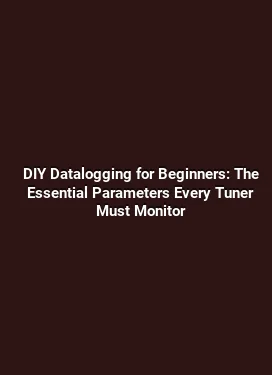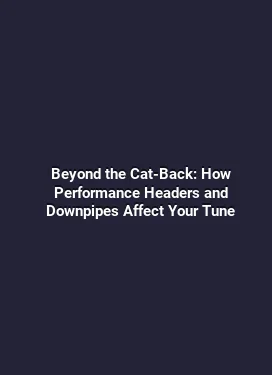Best Timing Chain Upgrade Kits for High RPM Engine Applications
Understanding High RPM Demands on Timing Chains

In high RPM engine builds, timing chain systems are pushed beyond ordinary daily-driving requirements. The timing chain and related components must withstand rapid acceleration, high lateral forces, thermal cycling, and sustained valve train loads. Upgraded timing chain kits are designed to improve durability, reduce stretch, and maintain precise valve timing across a broad RPM range. When evaluating upgrade options, it is essential to consider chain material, tensile strength, roller design, sprocket geometry, and tensioning strategy. These factors influence reliability, horsepower retention, and the ability to sustain aggressive ignition and fueling maps without timing drift.
High RPM scenarios often involve aggressive cam profiles, higher valve spring pressures, and potential oiling challenges. A robust timing system helps prevent retarded or advanced timing events that can lead to misfires, valve float, or piston-to-valve interference. The goal of a dedicated upgrade is not only to endure higher loads but also to maintain consistent timing under demanding thermal and mechanical conditions. For enthusiasts chasing track days and endurance sessions, the timing chain upgrade becomes a fundamental part of the engine's reliability architecture.
Key performance drivers for timing chain systems

Material quality, such as case-hardened alloys or alloy steels, contributes to resilience against stretch and wear. Precision machined sprockets with optimized tooth profiles reduce side-loading and wear on the chain. A well-engineered tensioning system maintains optimal chain tension across rpm bands, preventing slack during acceleration while avoiding excessive preload that can cause premature wear. The interaction between chain, guides, and tensioners also affects parasitic losses and oil aeration, which become more significant in high RPM conditions.
Choosing the Right Timing Chain Upgrade Kit: Core Components and Considerations
Upgrading begins with a clear understanding of the kit’s core components: chain, sprockets, tensioners, guides, and any ancillary hardware. The best kits align with the engine's architecture, whether it uses a dual-row chain, a single-row setup, or a chain-driven hydraulic variable timing system. For high RPM engines, a kit that incorporates hardened roller chains, reinforced sideplates, and robust tensioners is typically preferred to minimize elongation and maintain timing accuracy under peak loads.
Beyond basic components, the kit should address lubrication strategy. High RPM operation increases oil film shear and cooler oil temperatures, so kits that integrate compatibility with extended oiling windows, improved splash lubrication paths, or dry-sump support are advantageous in demanding race environments. The compatibility with aftermarket camshafts, valve springs, and coil packs is another critical selection criterion, ensuring that the kit does not induce unintended timing variations when combined with aggressive bushing and bore clearances.
Material and design considerations
Materials play a central role in longevity. Hardened steel chains resist elongation, while coated surfaces reduce wear against hardened sprockets. Some upgrade kits employ nickel or chromium coatings to curb corrosion and friction. Sprocket geometry—such as optimized tooth profiles and staggered tooth counts—minimizes backdriving loads and improves meshing under high torque. It’s worth noting that a kit with a slightly heavier chain may offer better resonance damping in engines with extreme rpm appetite, at the expense of marginally higher rotating mass.
Installation Nuances: Ensuring Reliability in High RPM Scenarios
Installation quality is often the deciding factor between a marginal improvement and a durable upgrade. Proper timing alignment is essential, especially when converting to a higher-tension system or when upgrading to a different chain pitch. A precise setup uses reference marks, dial indicators, and, when available, factory service tools to measure chain stretch over the initial run-in period. Correct torque of sprockets and tensioners is also critical; over-tensioning can prematurely wear guides, while under-tensioning can cause flutter and timing drift at high rpm.
During installation, attention to oil supply and chain lubrication paths must be maintained. Some kits replace or reposition guides to enhance lubrication channels, reducing heat and wear. It is common to upgrade ancillary parts such as tensioner springs or dampers to match the new chain’s performance envelope. A meticulous approach includes inspecting mounting surfaces for cleanliness, verifying that no debris is present in the timing cover, and confirming that the chain has full travel range without binding through the entire rotation cycle.
Practical steps for a successful upgrade
Begin with a thorough teardown plan and a component inventory. Use a torque wrench with the correct spec for all fasteners and re-check torques after the initial engine run-in. When pairing with a high-lift cam or aggressive valve train, re-evaluate the belt or chain drive’s ability to handle added inertia. After installation, perform a controlled engine run to the target operating temperature and confirm there is no abnormal chain rattling or binding. A data-logging setup can track RPM, timing events, and oil pressure to verify stable operation under high-load conditions.
Testing and Tuning: Verifying Timing Integrity at Elevated RPM
Testing is not merely a post-installation checklist; it is a disciplined process that ensures the upgraded timing system behaves predictably across the engine’s RPM range. Baseline testing with a known, repeatable fuel map helps isolate the timing system’s contribution to performance. Subsequent dyno sessions should document timing stability, peak horsepower, and torque curves to determine whether the kit maintains consistent timing under high torque pulses. It is common to observe a small degree of retardation or advancement as the system settles in, which can be mitigated with refined cam phasing maps or revised tensioning settings.
Advanced tuning scenarios involve traceable data collection: crank and cam sensor signals, chain tension feedback (if available), and oil temperature monitoring during high-RPM runs. A well-tuned system maintains a narrow timing envelope, ensuring that at each RPM segment the valve events align with combustion timing for optimal efficiency and power. In forced induction setups, upgrade kits often require even tighter control of timing to prevent detonation and to preserve fuel economy under high boost conditions.
Practical tuning strategies for high RPM engines
Adjust timing maps to account for thermal growth, oil pressure changes, and potential flutter at the upper rpm limit. Consider a staged approach to cam timing, beginning with conservative adjustments and progressively advancing or retarding timing in small increments. Use a wide-band oxygen sensor and data logging to correlate timing changes with AFR (air-fuel ratio) and ignition advance. In endurance applications, incorporate a safeguards strategy such as an alarm threshold for valve train load or unusual timing drift, enabling pre-emptive maintenance before a failure occurs.
Maintenance and Longevity: Extending the Life of Your Timing Chain Upgrade
Even the best kits require maintenance to deliver consistent performance over time. Routine inspection of the chain for elongation, wear marks on sprockets, and wear patterns on guides is essential. A periodic check can identify early signs of wear before a failure occurs at high RPM. Lubrication quality plays a decisive role in longevity; low viscosity oil in high-load environments can reduce friction but may not provide sufficient film strength at elevated temperatures. Selecting an oil with adequate film strength and antioxidant properties is crucial in maintaining timing system integrity under track conditions.
It is also prudent to inspect related components: tensioner springs, dampers, and mounting bolts should be checked for bypass movement, play, and secure engagement. If a kit includes upgraded tensioners with higher load capacity, ensure that installation torque and alignment are re-checked after a track session. Proper maintenance reduces the risk of chain slip, excessive wear, and timing drift, which is particularly important for engines operating near their redline for extended periods.
Common maintenance pitfalls to avoid
A frequent mistake is neglecting oil system upgrades when moving to a higher rpm regime. Inadequate lubrication can accelerate wear on the chain and guides, negating the benefits of the upgrade. Another pitfall is failing to re-tune ignition timing after installation; small deviations can cause detonation or misfire at high RPM. Finally, skipping a comprehensive break-in period can conceal early wear or bedding issues that only appear after sustained use at speed.
In summary, the combination of robust materials, precise engineering, meticulous installation, and disciplined testing yields the best performance from timing chain upgrade kits in high RPM engines. The right kit not only improves resilience against stretch and wear but also supports consistent timing behavior across aggressive operating regimes, helping engines meet the demands of modern tuning and competitive racing environments.






